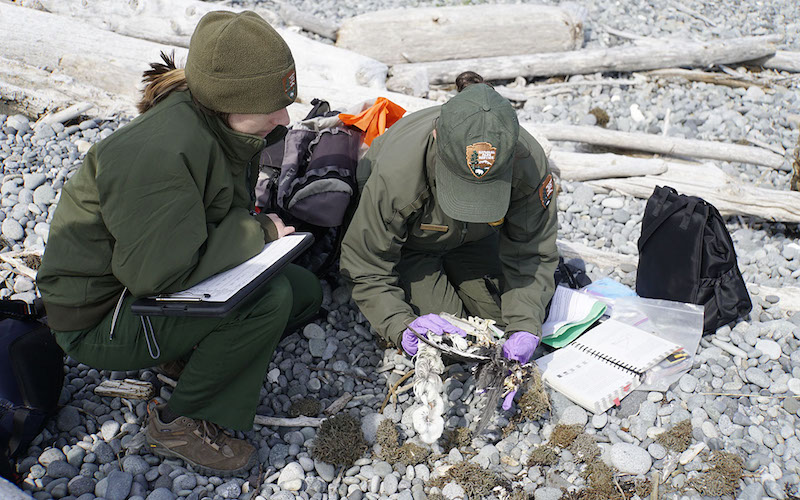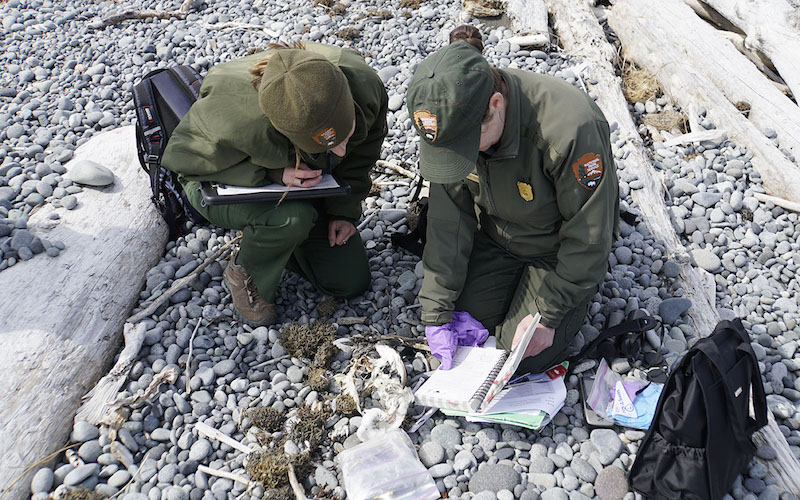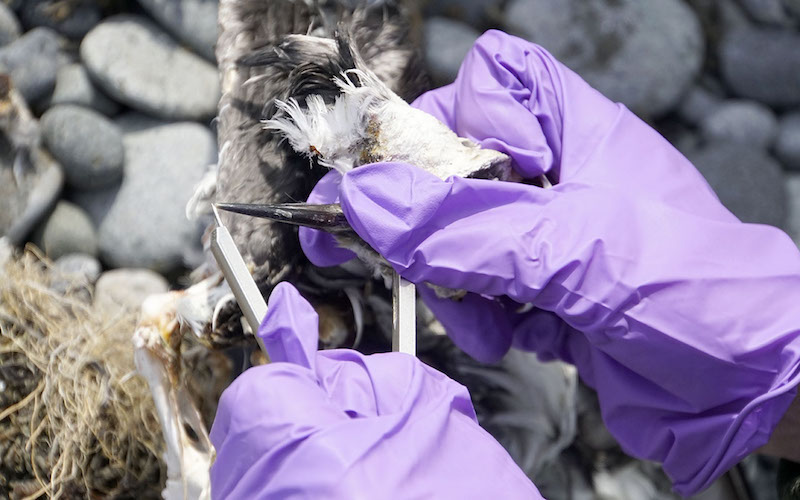At first sight, the beach at Swikshak Bay looks normal -- with the typical logs, vegetation, and some marine debris washed up. It wasn’t until closer inspection that we started seeing dead common murres every 5-10 meters. The long-term monitoring program coordinated by COASST (Coastal Observation and Seabird Survey Team) helps monitor coastal bird mortality and carcass persistence. The survey has been conducted in Katmai National Park since 2012.
During the summer of 2015, park rangers and guides observed a larger number of dead seabirds, primarily common murres, along the coast than in previous years. Unusual common murre activity was also documented in Marine Bird and Mammal Surveys conducted in July by the National Park Service’s Southwest Alaska Network as part of an annual nearshore-monitoring program. This survey recorded much higher numbers of live common murres during a time when these birds would usually be at their colonies. In Katmai National Park and Preserve there are no common murre colonies and densities of murres are generally low. The 2015 die-off is speculated to be due to higher ocean water temperature that may have disrupted prey abundance and availability. Fresh carcasses were sent to the National Wildlife Health Center last summer and cause of death was determined to be starvation. The mortality event may still be ongoing and this summer’s COASST survey helps serve as a follow-up to last year’s observations as we wait for answers about the die-off.

Rangers Kelsey and Carissa examine a seabird carcass at Swikshak Bay. Photo by NPS/K. Kunce.
This COASST survey at Swikshak Bay involved walking 1 km of beach, searching for dead birds from the tideline up to the high point on the beach. All we could hear was the crunch of the rocks under our feet, the wind, and the waves from the ocean. Surprisingly, it was difficult to find the birds at first. The carcasses had been scavenged, decayed, and weathered quite a bit and blended in with the color tone of the rocks. When we found a bird, we identified to species using a bird specimen key, which uses foot, wing or beak measurements along with color and plumage characteristics. Once we found one though, more seemed to appear as if out of thin air. As we looked down the set area of beach, seeing more and more birds, we began to wonder if we had enough time to complete the survey. With bird carcasses you may not have all of the parts you need to make an identification, in which case the specimen is recorded as unknown. Once identified, we record where the bird was found, the body parts included, and the condition of the parts. The age of the bird can be determined by its plumage and bill length.

Rangers Kelsey and Carissa identify a bird carcass in Swikshak Bay. Photo by NPS/K. Kunce.

Measuring bill length to determine age. Photo by NPS/K. Kunce.
We then tag the specimen on the right wing, if present, using different colored zip ties. Each color represents a corresponding number in our data. In 1 km of beach at Swikshak Bay we documented almost 100 birds, when it is usually just one or zero. The vast majority of them were common murres associated with last year’s die-off event. Later this summer, we will conduct another survey to see if any of the tagged birds are still present and record and tag new bird carcasses.

The completed documented and tagged common murre carcass. Photo by NPS/K. Kunce.
Though I would much rather document birds when they are alive, these types of surveys help scientists gain a better understanding of natural trends in bird mortality, as well as identify and measure bird mortality events. Long-term monitoring can show us when there are increases in coastal bird deaths, like last year. Soon, scientists hope to determine the causes of the murre die-off. This knowledge can further inform us about human and natural impacts on coastal birds and marine ecosystems. **COASST is a citizen science project of the University of Washington. By collaborating with citizens, natural resource management agencies and environmental organizations, COASST works to translate long-term monitoring into effective marine conservation solutions.If you are along the Pacific-West Coast and want to participate in one of the many COASST surveys, check out their training calendar and volunteer.
